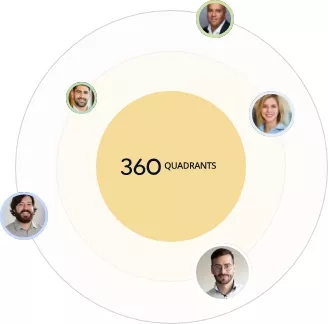A rangefinder is a device that uses methods, including unilateral transmission and passive reflection to measure the distance from an observer to a target. This process of measuring the distance is known as ranging. There are several types of rangefinders, such as laser rangefinder (LRF) and ultrasonic rangefinder. A rangefinder is used in various applications, including defense, sports, construction, photography, robotics, and virtual reality.
The Rangefinder vendors are placed into 4 categories based on their performance and reviews in each criterion: “visionary leaders,” “innovators,” “dynamic differentiators,” and “emerging companies".
The companies that fall under this category generally receive high scores for most of the evaluation criteria. They have a well-established product portfolio and a very strong market presence. They offer mature and reputable products and services and have strong business strategies.
Dynamic differentiators are the established vendors of radar simulators with strong business strategies. However, they have weaker product portfolios as compared to their competitors. They generally focus on a specific type of technology related to a particular product.
Innovators are the vendors that have demonstrated substantial product innovations as compared to their competitors. They have an extensive product portfolio. However, they do not have very strong growth strategies for their overall business.
Vendors with niche product offerings, who have started to gain their foothold in the radar simulator market, fall under this category. They do not have strong business strategies as compared to other established vendors. They might be new entrants in the market and require some time before gaining significant traction in the market. The commercial segment includes industrial robotics, construction, automotive, and photography. Ultrasound and LRFs are used in different commercial industries for ranging, identification, and situation awareness of automotive, industrial robotics, and construction activities. Increase in demand for commercial use of rangefinders is expected to drive the automotive rangefinder segment. Automation requires high-end rangefinders, such as lasers, which are replacing the ultrasonic rangefinders. The defense end use segment has been divided into airborne, marine, and ground-based. The airborne subsegment has been further classified into aircrafts, missiles, and UAVs. The marine subsegment has been categorized into ships and submarines. The ground-based subsegment has been categorized into tanks, hand-held, and UGVs. The airborne subsegment of the defense segment includes aircrafts, missiles, and UAVs. The use of LRFs on airborne platforms provides ranging capabilities to fire control and weapon systems in aircrafts. A LRF can provide information on range, even if the target is beyond the scope of active range. Rangefinders mounted on guided missiles are capable of calculating the distance of very short distance targets using laser waves. However, the heavy weight acts as a barrier for LRF use in airborne applications. Thus, rangefinder manufacturers are developing lightweight systems to increase their applications in UAVs and aircrafts.



